
Kea DHCP
(Migrating to Kea from ISC DHCP)
Carsten Strotmann and the ISC KEA Team
Created: 2020-12-02 Wed 11:31
All content © 2020 Internet Systems Consortium, Inc.


Software Migrations
All content © 2020 Internet Systems Consortium, Inc.


About migrations
- Migrations from old to new software products are required from time to time
- Not all software can be upgraded to new functionality
- Sometimes a clean start is needed to update the underlying implementation
- Such new implementations often cannot provide 100% compatibility
- Examples: BIND 8 -> BIND 9, Python2 -> Python3, ISC DHCP -> Kea DHCP
All content © 2020 Internet Systems Consortium, Inc.


Migration strategies
- Possible migration strategies
- Upgrade of the existing infrastructure
- Re-design of the existing infrastructure
All content © 2020 Internet Systems Consortium, Inc.


Re-Design of an existing infrastructure
- A re-design can be used to remove shortcomings of the old design
- A migration is a good time to review the current design
- A new design can make use of modern features that were not available at the time of the original design
- Maybe it is time to introduce IPv6?
- Implement new features
- Automatic configuration management
- Monitoring
- Better documentation
All content © 2020 Internet Systems Consortium, Inc.


Configuration migration
- A DHCP configuration can be quite complex
- Migrating such a configuration can be challenging
- There could be unknown pitfalls
- Testing and Monitoring are important (the Kea DHCP team has created tools to help with this)
All content © 2020 Internet Systems Consortium, Inc.


About automated configuration migration
- Automated migration of an existing DHCP configuration might be possible
- But be aware:
- automated migrations don't utilize the power of the new system
- automated migrations create a non-optimal configuration that might be harder to maintain
- Recommendation: if possible, take time and do a manual migration
All content © 2020 Internet Systems Consortium, Inc.


Kea Migration Assistant (KeaMA)
All content © 2020 Internet Systems Consortium, Inc.


Kea Migration Assistant (KeaMA)
- The Kea Migration Assistant (KeaMA) is a tool provided by ISC to
help migrating an existing ISC DHCP configuration to Kea DHCP
- the output of KeaMA can be used as a starting point for creating a Kea DHCP configuration
- don't expect miracles from KeaMA: in most cases, it will not be able to convert the complete ISC DHCP configuration
All content © 2020 Internet Systems Consortium, Inc.


What KeaMA can do
- KeaMA is good at converting simple configuration structures
- Reservations
- Subnet and Shared-Network definitions
- DHCP Option definitions
All content © 2020 Internet Systems Consortium, Inc.


What KeaMA cannot do
- There are some ISC DHCP configuration statements that cannot be
translated into a Kea DHCP configuration
- configurations where ISC DHCP and Kea DHCP differ
- Failover vs. High-Availability
- Support for hardware types other than Ethernet
- Shared-Network pools
- ISC DHCP spawning classes
- …
- configurations where ISC DHCP and Kea DHCP differ
All content © 2020 Internet Systems Consortium, Inc.


Building Kea Migration Assistant (KeaMA)
- KeaMA is part of the ISC DHCP Server
- It reuses the ISC DHCP configuration file parser
- ISC provides experimental RPM/DEB packages on Cloudsmith: https://cloudsmith.io/~isc/repos/keama/packages/
- It is recommended to install and use KeaMA on a dedicated migration machine
- copy the ISC DHCP configuration to that machine and migrate the configuration there
All content © 2020 Internet Systems Consortium, Inc.


KeaMA: getting the source
- Download the latest ISC DHCP source code and extract the tar file
wget http://ftp.isc.org/isc/dhcp/4.4.2/dhcp-4.4.2.tar.gz tar xvfz dhcp-4.4.2.tar.gz
All content © 2020 Internet Systems Consortium, Inc.


KeaMA: preparing the source
- The KeaMA source must be adjusted to be compiled on your Linux/Unix
system and hardware architecture
- the
configurescript will check the running operating system and will create the build files required to compile KeaMA
- the
cd dhcp-4.2.2/ ./configure
All content © 2020 Internet Systems Consortium, Inc.


KeaMA: Compile from source
- Once the
configurescript returns without error, the KeaMA tool can be build
cd keama make
All content © 2020 Internet Systems Consortium, Inc.


KeaMA: using KeaMA
- it is not required to install KeaMA, it can be used directly from the build directory
- KeaMA syntax
keama [ -4 | -6] [ -D ] [ -N ] [ -r {perform|fatal|pass} ] \
[ -l hook-library-path ] [ -i input-file ] [ -o output-file ]
All content © 2020 Internet Systems Consortium, Inc.


KeaMA: Example usage
- this is an example of using KeaMA on an ISC DHCPv4 configuration
file
- the option
-Nwill place host reservations in the appropriate subnet - the option
-r passwill pass host names into the Kea DHCP configuration. Often these host names need to be replaced with their IP addresses manually.
- the option
./keama -4 -N -r pass -i dhcpd.conf -o kea-dhcp4.conf
All content © 2020 Internet Systems Consortium, Inc.


KeaMA: example result
- Comments point to parts of the configuration that most likely need manual adjustment
- Known issues are referenced with their Gitlab issue number
- Example: Issue #245 below can be found at https://gitlab.isc.org/isc-projects/kea/-/issues/245
{
# dhcpd.conf
/// This configuration declares some subnets but has no interfaces-config
/// Reference Kea #245
"Dhcp4": {
// "statement": {
// "config": {
// "value": "allow",
// "name": "allow-booting",
// "code": 9
// }
// },
"dhcp-ddns": {
"qualifying-suffix": "home.example.com",
"enable-updates": true
},
[...]
All content © 2020 Internet Systems Consortium, Inc.


Differences between Kea and ISC DHCP
All content © 2020 Internet Systems Consortium, Inc.


Shared Networks
- ISC DHCP permits pools at shared-network level
- In Kea DHCP, a pool must belong to a subnet
- In Kea DHCP, selecting a lease from a shared-network has a performance penalty compared to selecting a lease from a plain subnet
All content © 2020 Internet Systems Consortium, Inc.


Client classification
- Kea DHCP does not have a concept similar to
permitordenyin ISC DHCP- In ISC DHCP, this is used to permit or deny certain client classes in subnets
- This can be done in Kea DHCP as well, but the logic is different
- Kea DHCP does not support spawning classes (which are used for
dynamic lease limit configurations)
- There is (currently) no per client / per class lease limit in Kea DHCP
All content © 2020 Internet Systems Consortium, Inc.


DHCP Options
- ISC DHCP can resolve DNS names to IP addresses for options that
require an IP address. Kea DHCP does not resolve DNS names
- The Kea Migration Assistant can resolve the DNS names into IP addresses while converting an ISC DHCP configuration
- Option inheritance scoping is different between ISC DHCP and Kea DHCP
All content © 2020 Internet Systems Consortium, Inc.


High-Availability
- ISC DHCP supports the IETF DHCPv4 Failover Protocol draft https://datatracker.ietf.org/doc/html/draft-ietf-dhc-failover
- Kea DHCP supports its own DHCP high availability implementation for DHCPv6 and DHCPv4
- Both create a highly available DHCP service, but the implementation and configuration details are different
- Document comparing failover in ISC DHCP to HA in Kea DHCP https://kb.isc.org/docs/aa-01617
All content © 2020 Internet Systems Consortium, Inc.


Kea High Availability vs ISC DHCP Failover (1)
- Number of servers in an HA cluster
- ISC DHCP: 2
- Kea DHCP: 2 active + unlimited backup servers
- Failover relationships
- ISC DHCP: one per subnet
- Kea DHCP: one per instance
- Load balancing
- ISC DHCP: Flexible split (RFC3074)
- Kea DHCP: fixed 50/50 split (RFC3074)
All content © 2020 Internet Systems Consortium, Inc.


Kea High Availability vs ISC DHCP Failover (2)
- Lazy lease updates (MCLT)
- ISC DHCP: yes (server responds to the client immediately)
- Kea DHCP: no (server waits for lease update completion before responding to client)
- Send lease updates to external entity
- ISC DHCP: no
- Kea DHCP: yes (via backup server or custom hook library)
- Rebalancing pools
- ISC DHCP: yes
- Kea DHCP: no
All content © 2020 Internet Systems Consortium, Inc.


Kea High Availability vs ISC DHCP Failover (3)
- Database replication for sharing lease info
- ISC DHCP: no
- Kea DHCP: yes (optional)
- API
- ISC DHCP: omapi
- Kea DHCP: RESTful API
All content © 2020 Internet Systems Consortium, Inc.


Host reservations
- In ISC DHCP all host declarations are global
- Kea DHCP supports global and per-subnet/shared-network reservations
- ISC DHCP can have reservations that are not viable on the subnet
where the clients are attached
- Kea does not start if configured with an address or prefix that is not viable on its subnet; it displays an error
All content © 2020 Internet Systems Consortium, Inc.


Scripts and Tools
- Most 3rd party tools and scripts that work with ISC DHCP do not
work with Kea DHCP
- parse lease file
- SNMP monitoring agents
- Configuration orchestration
- Many use cases are covered by the Kea API
All content © 2020 Internet Systems Consortium, Inc.


Manual Migration
All content © 2020 Internet Systems Consortium, Inc.


Client Classes
- The Kea Migration Assistant will translate the client
classification rules from ISC DHCP to Kea DHCP
- the Kea DHCP configuration will have the original client classification as a comment
[...]
"client-classes": [
{
"name": "virtualbox",
/// from: match if (substring(hardware, 1, 3)) = 0x080027
"test": "substring(pkt4.mac,0,3) == 0x080027"
},
[...]
- Understanding Client Classification https://kb.isc.org/docs/understanding-client-classification
All content © 2020 Internet Systems Consortium, Inc.


Client Classes
- review and, if possible, simplify the client classification tests
- Kea DHCP might have expressions that better define the class
- Using Expressions in Classification: https://kea.readthedocs.io/en/kea-1.8.1/arm/classify.html#using-expressions-in-classification
[...]
{
"name": "gen#virtualbox#!KNOWN#_AND_#!microsoft-client#",
"test": "(member('virtualbox') or not member('KNOWN')) and not member('microsoft-client')"
},
{
"name": "gen#!KNOWN#_AND_#!virtualbox#!microsoft-client#",
"test": "(not member('KNOWN')) and not member('virtualbox') and not member('microsoft-client')"
}
[...]
All content © 2020 Internet Systems Consortium, Inc.


Expressions
- ISC DHCP allows complex expressions in the configuration file
- The ISC DHCP configuration file is almost a programming language
- Most effects of ISC DHCP expressions can be created with the Kea
DHCP functions, or existing hook libraries (
flex_idorflex_optionhooks) - In other cases, a custom hook can be used to implement almost
any logic required
- 3rd party hook examples: https://github.com/search?q=kea+hook
All content © 2020 Internet Systems Consortium, Inc.


Custom Kea hooks
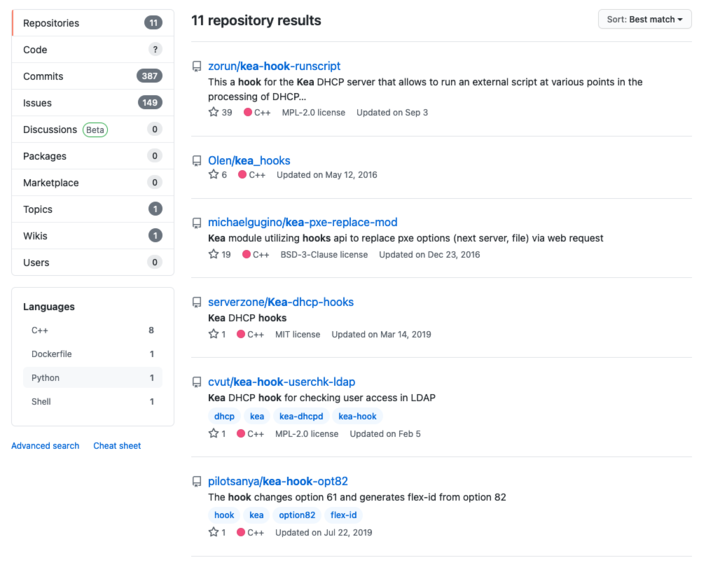
All content © 2020 Internet Systems Consortium, Inc.


ISC DHCP to Kea DHCP Migration Plan
All content © 2020 Internet Systems Consortium, Inc.


Proposed migration steps
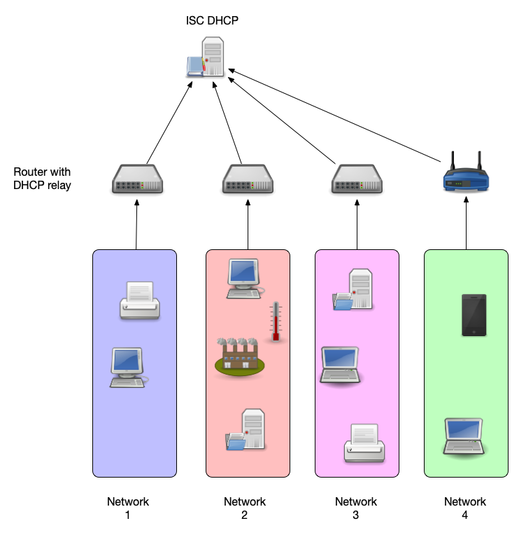
All content © 2020 Internet Systems Consortium, Inc.


Proposed migration steps
- Get familiar with Kea DHCP
- run a production Kea DHCP for some time (some month) in a small and low risk network
- test features that will be used in the larger production networks
All content © 2020 Internet Systems Consortium, Inc.


Proposed migration steps
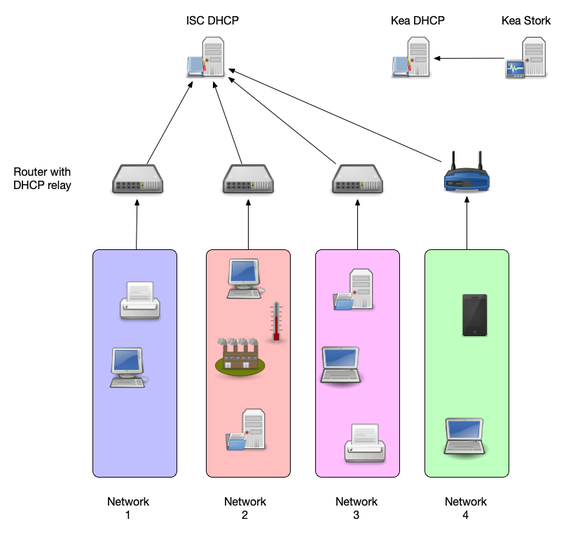
All content © 2020 Internet Systems Consortium, Inc.


Proposed migration steps
- Install Kea DHCP alongside the existing ISC DHCP
- Write and test the Kea DHCP configuration
- configure the DHCP relays to forward DHCP messages to ISC DHCP
(production) and Kea DHCP (test)
- block the responses from Kea DHCP in the host firewall of the Kea DHCP OS (for example Linux nftables)
- inspect the responses from Kea DHCP and compare with the responses from ISC DHCP
- configure the DHCP relays to forward DHCP messages to ISC DHCP
(production) and Kea DHCP (test)
- Implement Logging and Monitoring
All content © 2020 Internet Systems Consortium, Inc.


Proposed migration steps
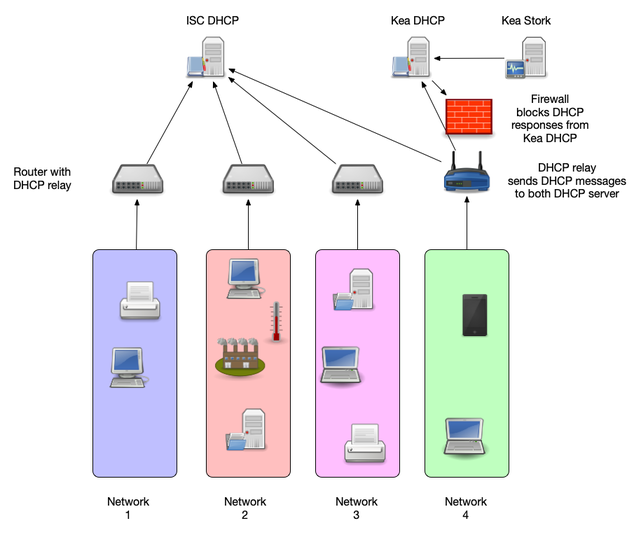
All content © 2020 Internet Systems Consortium, Inc.


Proposed migration steps
- Define the time line for the migration
- Lower the lease/refresh times on the ISC DHCP before the migration
- One hour DHCP refresh is safe for most devices
- Modern operating systems (Windows, Linux, macOS etc) can work with low DHCP refresh times, such as 5 minutes
- Embedded or older DHCP clients (MS-DOS, Windows 9x, QNX etc) that can be found in industrial control units need safe refresh values
All content © 2020 Internet Systems Consortium, Inc.


Proposed migration steps
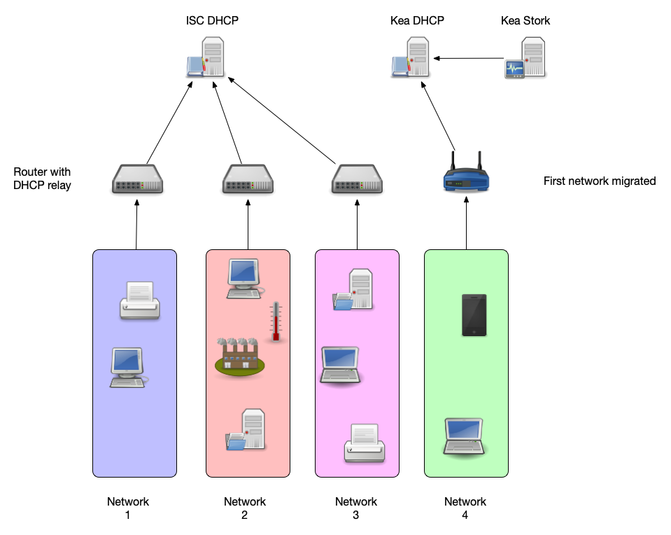
All content © 2020 Internet Systems Consortium, Inc.


Proposed migration steps
- Start with a friendly crowd, low risk network (IT department WLAN)
- Switch networks one-by-one via DHCP relay configuration
- On regression, switch back to ISC DHCP for this one network and investigate
All content © 2020 Internet Systems Consortium, Inc.


Proposed migration steps
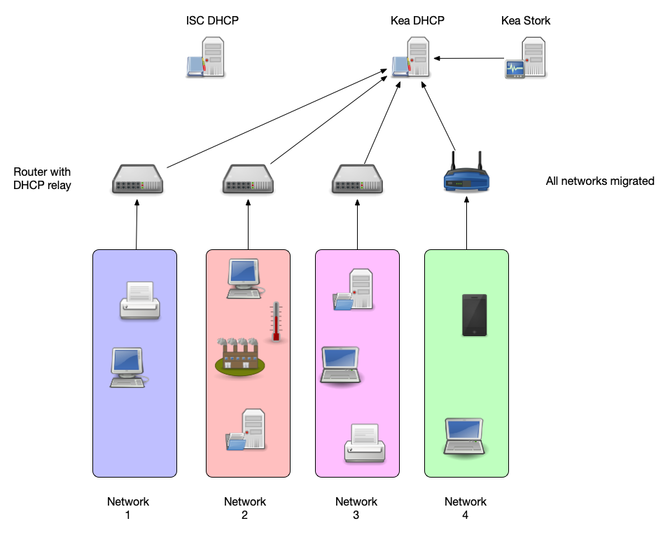
All content © 2020 Internet Systems Consortium, Inc.


Proposed migration steps
- Monitor leases on the ISC DHCP as well
- At some point in time, there should be no DHCP requests coming to the old server(s)
- time to shut the old systems down
All content © 2020 Internet Systems Consortium, Inc.


Proposed migration steps
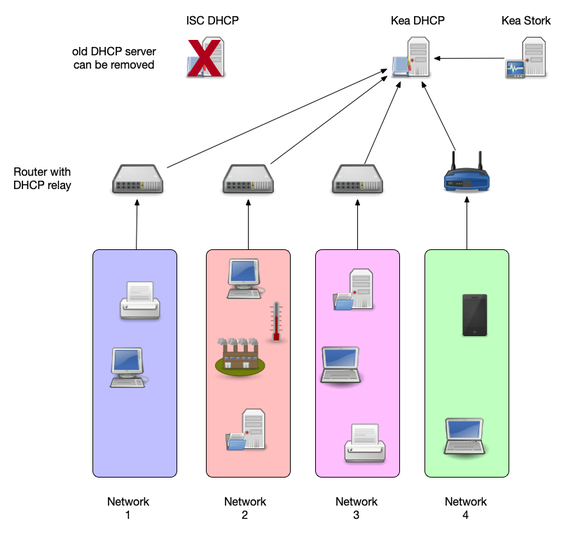
All content © 2020 Internet Systems Consortium, Inc.


Next Webinars
ISC webinars are taking a break until the new year and ISC will announce new webinars early in 2021.
All content © 2020 Internet Systems Consortium, Inc.


Resources
- Alan Clegg – NANOG 76 - DHCP Migration to Kea
- Kea High Availability vs ISC DHCP Failover
- Kea HA Design Document
- Available 3rd party hooks for Kea DHCP
- Using Host Reservations in Kea
All content © 2020 Internet Systems Consortium, Inc.


Questions and Answers
All content © 2020 Internet Systems Consortium, Inc.
